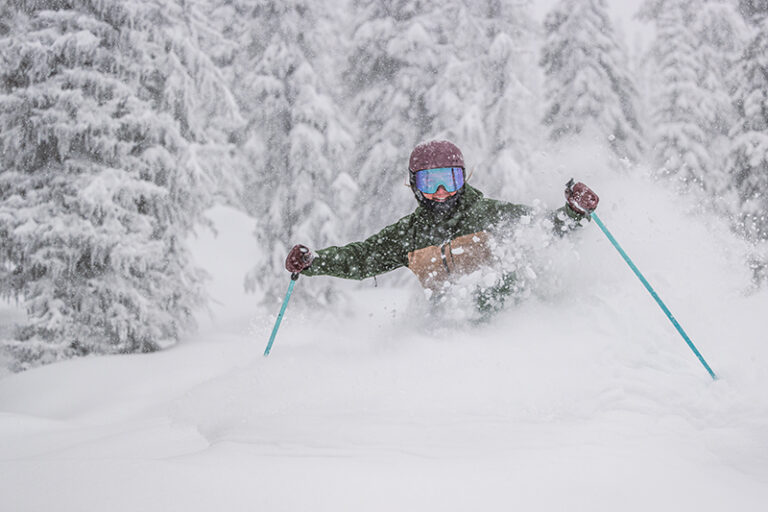I move carefully through the rocky Red Banks section on Mt. Shasta after summiting in the early morning. Traversing a little lower to one of many massive snowfields, I sit down on the mash potato snow and prepare for what is perhaps the longest glissade in the lower 48. It’s a bit steep, and I keep my crampons on until I’m ready to commit to the long descent. My partner has paused to set up his splitboard, and I want to have eyes on him before continuing down the slope.
That’s when I hear an unexpected “Hey!” from a professional guide about 100 yards away. His exclamation echoes with a tinge of urgency. He’s breathing easily at 12,000 feet while the client he’s short roped to sits and gulps down air. I can feel him scanning my set up and position from behind his reflective glacier glasses. “Hey! You shouldn’t glissade with crampons on.”
When I first heard the term glissade a few years back, I imagined alpine wizards performing ice-axe trickery up steep terrain. Turns out, glissading is a fancy term for sliding down a mountain on your hind parts. You’re not supposed to glissade with crampons on because the sharp metal teeth of the steel or aluminum footwear can dig into the snow, securing your leg in place as the rest of your body shoots down the mountain. The 2017 “Accidents in North American Climbing” reports that glissading is the most common injury on Mt. Shasta.
“OK.” I yell back. I wasn’t sure how to catalogue his unsolicited advice. That he assumed I was about to make a poor decision annoyed me, but I also didn’t fault him for speaking up about a safety issue. He would have been first on scene had my tibia snapped. He also knew about the large concert of people and resources needed to extract any injured climber and did not want to mobilize Search and Rescue for an avoidable mistake.
Farther down the mountain, in the heat of the day, the snow turns to total mush. I’m now skating down the mountain in wet boots, a bit worried about the tendons in my knees, but I can no longer glissade. After more than 3,000 vertical feet of descent, my butt has turned into a numb stump.
“Hey!” I hear again. This time a man in his mid-20s with a first trimester beer belly evaluates me and my set up. Sweat gushes out of his pores. Judging by the time of day and the size of his pack, I see that he is geared up for an overnight trip.
“Hey,” he says, “You should be glissading—not walking—down the mountain.” A flurry of indignant responses queues up in my brain: You should mind your own business. You should kiss my ass and, because it’s so cold, see if your lips stick to it. You should hit the gym more often so you can gain 7,000 vertical feet in a day like me.
When my partner Matt and I debriefed the climb, we chuckled about these two men and their somewhat contradictory advice. But I’ve often thought about that day—and many other incidents of unsolicited advice—and have tried to unpack what those scenarios reveal about those men, and what they say about me.
The situation with the guide is complicated because his advice was safety related, and he was right—you shouldn’t glissade with crampons on. But why didn’t he give me the benefit of the doubt? And how much did being a woman contribute to those doubts?
If I were generous, I’d say the second guy wanted to save the tendons in my knees. But here’s what it felt like in the moment: He seemed arrogant and douche-y. He thought he knew something that I didn’t and wanted to sound smart among the members of his group. He assumed my inexperience so that he could sound accomplished.
One arrogant and douche-y comment, of course, isn’t that big of a deal; but a lifetime of fielding them has made me guarded and less likely to absorb the good kind of advice—the peer-to-peer learning that has always been part of mountaineering.
In many ways, there’s never been a better time to be a female athlete. We climb in pants instead of corseted skirts, and no one’s saying that we can’t push ourselves lest our uteruses detach and float recklessly around our bodies (no, really—American doctors used to believe this). But while societal expectations have shifted and sports are more inclusive, we still experience exclusion of a finer grain. There are a lot of people out there—men and women alike—who habitually think less of us.
I believe we need to be honest about and open to exploring our unconscious attitudes. We can’t help that we inherited a world full of stereotypes, but we can come together, examine our implicit biases, and be intentional about ditching the old ways of treating each other that no longer serve us. //
Summer Hess is the Managing Editor of Out There Outdoors. She invites you to join her and EPIC Adventures on March 2 for a screening of No Man’s Land—an adventure film festival that highlights female athletes and acts as a platform for progressive thought in the outdoor industry.













